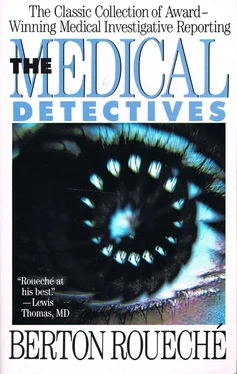The time, as it turned out, was only a few weeks off. Pasteur Ireated his first human patient on July 6, 1885. This now famous pioneer was a nine-year-old Alsatian boy named Joseph Meister. Two days before, while walking on a country road near his home, he had been attacked by a plainly rabid dog, knocked down, and bitten fourteen times. When Pasteur saw him, at the request of a family doctor, the boy was more dead than alive. In fact, Pasteur later recalled, it was only the apparent hopelessness of the case that induced him to attempt its treatment. The procedure he used was a freehand adaptation of the one he had developed in his most recent experiments with dogs, and it took ten days. During that time, the boy received thirteen inoculations, of increasingly potent vaccine. His immediate reaction was encouraging, and it continued satisfactory throughout the treatment. At the end of a month, his wounds having healed, he seemed to be fully recovered. He was. Joseph Meister lived to be sixty-four. He died in 1940, a suicide.
The rehabilitation of Joseph Meister, which Pasteur described in a paper, entitled "Methode pour Prevenir la Rage apres Morsure" and presented at a meeting of the Academie des Sciences on October 26, 1885, created an instant and appreciative stir throughout the medical world. "[Rabies], that dread disease against which all therapeutic measures had hitherto failed, has at last found a remedy," the formidable neuropathologist Edme-Felix-Alfred Vulpian proclaimed. Assisted by this and other resounding testimonials, the Pasteur treatment, as the procedure came to be called, was in international use within a decade, and it has since been administered many thousands of times, with sufficient success to establish its worth as a reliable defensive tool. Or so it is generally assumed. To what extent the Pasteur treatment protects human beings against the development of rabies, however, is not known, and probably (in view of the natural scarcity of volunteers available for a series of controlled experiments) never will be. Its powers, in any event, are somewhat less than total. In a recent monograph, Harald N. Johnson, a staff member of the Rockefeller Foundation, observes, "On the basis of clinical evidence, there seems to be no doubt that rabies vaccine is effective in preventing the disease in the majority of the instances in which there is an expected incubation period of more than one month." But such an incubation period can only be expected in cases involving bites on the arms, legs, or torso. The chances that the Pasteur treatment will prevent the development of the disease when the victim is bitten severely on the head or neck are slight.
Only one more or less controlled test of rabies immunization in human beings has ever been made. That was conducted by a World Health Organization team in 1954, in Iran. Its purpose was to evaluate an antirabies serum developed that year by Hilary Koprowski, assistant director of viral and rickettsial research at the Lederle Laboratories of the American Cyanamid Company. Serum differs from vaccine in that it contains—rather than merely stimulates the body to produce—the immunizing agents known as antibodies. A rabid wolf had burst into a mountain village, not far from the W. H. O. team's station, and bitten twenty-nine men, women, and children. As a matter of course, the Pasteur treatment was prescribed at once for all the victims. In addition, seventeen of the group, whose wounds included bites on the head or neck, were given immediate injections of serum. Eleven of them received one injection, the others two or more. The results were unmistakably clear. Twenty-five of the victims, including all who had received at least two injections of serum, survived. Of the four who died, three had been given only the Pasteur treatment, and the other a single serum inoculation. The limited efficacy of the Pasteur treatment is not, unfortunately, its only flaw. It has others. 1t is unpleasantly long (the present regimen, even when supplemented by serum, requires from fourteen to twenty-one days), it is, usually expensive (the average injection costs about five dollars), and, above all, it is disturbingly dangerous. Reactions to antirabies treatment range from those common in allergic conditions—erythematous or urticarial rashes, edema, syncope—to one known as neuroparalytic accident. Neuroparalytic accident varies in degree from a polyneuritis to ascending encephalomyelitis. The latter, in an uncomfortable number of cases, is permanently incapacitating, and sometimes fatal.
The imperfections of the Pasteur treatment are not, of course, sufficient to deny it a place in the modern medical kit. There is, after all, nothing with which to replace it. In the opinion of most investigators, however, the imperfections are pronounced enough to discourage its use in any but cases of certain—or suspicious but unverifiable—exposure. It is also their urgent conviction that postexposure prophylaxis is, at best, an indirect defense against the menace of rabies. "There can be no question that the ultimate solution to the rabies problem is predicated on the control and eventual elimination of the disease from animal populations," the American Journal of Public Health commented editorially in May, 1955. "This may be accomplished by the setting up of transmission barriers, such as animal immunization, elimination of stray dogs, and the reduction of excessive numbers of wildlife vectors." It has been accomplished in a considerable number of countries. Britain, where a system of controls, rigidly enforced by the Ministry of Agriculture and Fisheries, was established around 1900, is perhaps the most notable of these. The last human exposure to rabies in England occurred nearly fifty years ago, and except for a handful of cases among imported dogs held in quarantine, there have been no outbreaks among animals there since shortly after the First World War. The Scandinavian countries—Denmark, Sweden, and Norway—have, by similar exertions, achieved almost as admirable a record, and so, among others, have Australia, New Zealand, and Malaya.
The record of the United States, despite the existence of an elaborate apparatus of legislative controls, is less imposing. Except for Hawaii, where rabies has somehow never gained a foothold, few parts of this country are wholly free of the disease. Last year (1953), around half a million Americans were treated for bites inflicted by animals. Of these, sixty thousand were judged to have been exposed to rabies and received the Pasteur treatment. Three of them died. There were nine additional fatalities among persons who received incomplete or no treatment. The lowest incidence of human rabies in recent years was ten cases, in 1949. The highest was fifty-six cases, in 1944. Among domestic animals the average annual mortality is between seven and eight thousand. The persistence of rabies in man and beast throughout the United States has been variously explained, but two factors are considered decisive. One of these is indifference. Although many states have laws that specify a certificate of vaccination as a prerequisite for obtaining a dog license, and although all make some provision for the disposal of strays, such measures are seldom enforced, and then only in moments of epidemic panic. The other is the still enormous number of wild animals among which the rabies organism is endlessly perpetuated. This indigenous reservoir includes not only such conspicuous vectors as the fox and the skunk but badgers, raccoons, beavers, squirrels, and, since the early nineteen-fifties, the insectivorous bat.
The full significance of the bat attacks on Frances Roberts, Carl Dayton, David Bonner, and Mabel Tate has yet to be determined. One thing, however, seems certain. These four people were not the victims of a fleeting freak of nature. Their experiences have since been duplicated elsewhere in the country. Three more attacks by rabid bats were reported in 1954. All occurred in Texas—the first, early in April, in San Antonio, and the second and third, in May and July, near Austin. The victims were a youth of twenty and two small children. Another was reported in October, 1955, in Madera, California, and involved a middle-aged man. Two more attacks—one certain and the other probable—were added to the record in 1956, and in May, 1957, an eleven-year-old boy was attacked near his home in Jamesville, Wisconsin, and bitten on the arm and chin. The 1956 victims were a soldier on maneuvers in Louisiana and a Texas State Health Department field epidemiologist named George C. Menzies. Dr. Menzies, at the time of his exposure, had been collecting specimens of cave-dwelling bats in central Texas to be examined for evidence of rabies infection. How and when he was exposed is not known. It is only known that he returned to his home, in Austin, on January 1, and the following morning developed symptoms of rabies. Two days later he was dead. The six other victims received the Pasteur treatment, and survived.
Читать дальше












